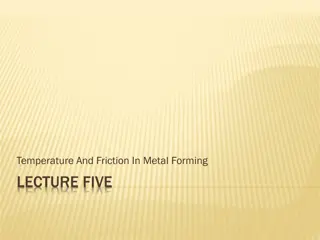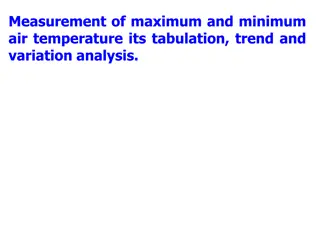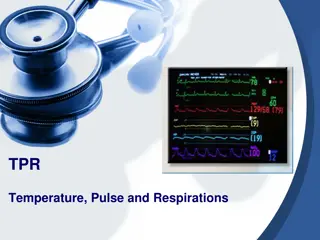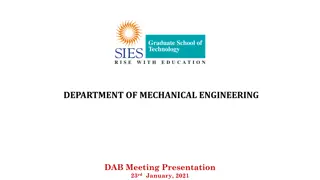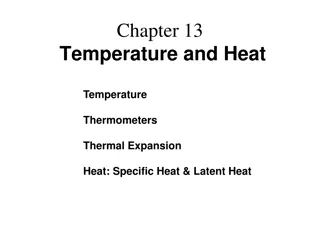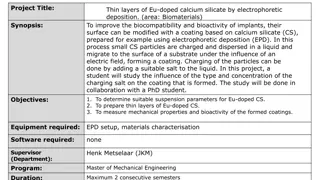Understanding Temperature Measurement in Mechanical Engineering
Exploring the concepts of temperature measurement in mechanical engineering, this article covers topics such as temperature scales, the ideal-gas thermometer, and the relationship between temperature and heat. With detailed explanations and visual aids, it provides insights into how temperature is measured and understood in engineering contexts.
- Temperature Measurement
- Mechanical Engineering
- Ideal Gas Thermometer
- Temperature Scales
- Heat Transfer
Download Presentation

Please find below an Image/Link to download the presentation.
The content on the website is provided AS IS for your information and personal use only. It may not be sold, licensed, or shared on other websites without obtaining consent from the author. Download presentation by click this link. If you encounter any issues during the download, it is possible that the publisher has removed the file from their server.
E N D
Presentation Transcript
Eastern Mediterranean University Faculty of Engineering Department of Mechanical Engineering MENG203 Lecture Notes
Chapter 8: The Measurement of Temperature
8.1 Introduction To most people, temperature is an intuitive concept that tells whether a body is hot or cold. In the exposition of the second law of thermodynamics temperature is related to heat, for it is known that heat flows temperature to a low temperature, in the absence of other effects. only from a high In the kinetic theory of gases and statistical thermodynamics it is shown that temperature is related to the average kinetic energy of the molecules of an ideal gas. The experimental engineer should be familiar with the methods employed measurement. in temperature
8.2 Temperature Scales The two temperature scales are the Fahrenheit and Celsius scales. These scales are based on a specification of the number of increments between the freezing point and boiling point of water at standard atmospheric pressure. The Celsius scale has 100 units between these points, while the Fahrenheit scale has 180 units. The absolute Celsius scale is called the Kelvin scale, while the absolute Fahrenheit scale is termed the Rankine scale
8.2 Temperature Scales The zero points on both absolute scales represent the same physical state, and the ratio of two values is the same, regardless of the absolute scale used; i.e., The boiling point of water at 1 atm is arbitrarily taken as 100 on the Celsius scale and 212 on the Fahrenheit scale.
8.3 The Ideal-Gas Thermometer The behavior of an ideal gas at low pressures furnishes the basis for a temperature measurement device that may serve as a secondary experimental standard. The ideal-gas equation of state is where V is the volume occupied by the gas, m is the mass, and R is the gas constant for the particular gas, given by where value of 8314.5 J/kg mol K, and M is the molecular weight of the gas. is the universal gas constant, having a
8.3 The Ideal-Gas Thermometer For the gas thermometer a fixed volume is filled with gas and exposed to the temperature to be measured, as shown in Fig. At the temperature T the gas-system pressure is measured. Next, the volume is exposed to a standard reference temperature and the pressure is measured under these conditions. According to ideal gas eq. at constant volume
8.3 The Ideal-Gas Thermometer Now, suppose that some of the gas is removed from the volume and the pressure measurements are repeated. Then the results plotted as in Fig. When the curve is extrapolated to zero pressure, the true temperature as defined by the ideal-gas equation of state will be obtained. A gas thermometer may be used to measure temperatures as low as 1 K by extrapolation.
8.4 Temperature Measurement by Mechanical Effect Several temperature-measurement devices may be classified as mechanically operative. In this sense we shall be concerned with those devices operating on the basis of a change in mechanical dimension with temperature. a change in The liquid-in-glass thermometer is one of the most common types of temperature measurement devices.
8.4 Temperature Measurement by Mechanical Effect A relatively large bulb at the lower portion of the thermometer holds the major portion of the liquid, which expands when heated and rises in the capillary tube, upon which are etched appropriate scale markings. At the top of the capillary tube another bulb is placed to provide a safety feature temperature range thermometer exceeded. Alcohol and mercury are the most commonly used liquids. in case of inadvertently the the is
8.4 Temperature Measurement by Mechanical Effect Alcohol has the advantage that it has a higher coefficient of expansion than mercury, but it is limited to low-temperature measurements because it tends to boil away at high temperatures. Mercury cannot be used below its freezing point of 38.78 F ( 37.8 C). The size of the capillary depends on the size of the sensing bulb, the liquid, and the desired temperature range for the thermometer.
8.4 Temperature Measurement by Mechanical Effect In operation, the bulb of the liquid-in-glass thermometer is exposed to the environment whose temperature is to be measured. Arise in temperature causes the liquid to expand in the bulb and rise in the capillary, thereby indicating the temperature. It is important to note that the expansion registered by the thermometer is the difference between the expansion of the liquid and the expansion of the glass.
8.5 Temperature Measurement by Electrical Effects Electrical methods of temperature measurement are very convenient because they furnish a signal that is easily detected, amplified, or used for control purposes. In addition, they are usually quite accurate when properly calibrated and compensated. Three methods: Electrical-Resistance Temperature Detector (RTD) Thermistors Thermoelectric Effects (Thermocouples) Thermometer, or Resistance
8.5 Temperature Measurement by Electrical Effects Electrical-Resistance Thermometer, or Resistance Temperature Detector (RTD) It consists of some type of resistive element, which is exposed to the temperature to be measured. The temperature is indicated through a measurement of the change in resistance of the element. Several types of materials may be used as resistive elements, and their characteristics are given in Table (next slide) The linear temperature coefficient of resistance is defined by where R2 and R1 are the resistances of the material at temperatures T2 and T1, respectively. Above eqn is usually applied over a narrow temperature range such that the variation of resistance with temperature approximates a linear relation.
8.5 Temperature Measurement by Electrical Effects Electrical-Resistance Thermometer, or Resistance Temperature Detector (RTD)
8.5 Temperature Measurement by Electrical Effects Thermistors The thermistor is a semiconductor device that has a negative temperature coefficient of resistance, in contrast to the positive coefficient displayed by most metals. Furthermore, the resistance follows an exponential variation with temperature where R0 is the resistance at the reference temperature T0 and is an experimentally determined constant. The numerical value of varies between 3500 and 4600 K, depending on the thermistor material and temperature.
8.5 Temperature Measurement by Electrical Effects Thermistors The resistivities of three thermistor materials as compared with platinum are given in Fig. https://youtu.be/9opuvLXAetI
8.5 Temperature Measurement by Electrical Effects Thermoelectric Effects (Thermocouples) The most common electrical method of temperature measurement uses the thermocouple. When two dissimilar metals are joined together as in Fig. an emf (electromotive force) will exist between the two points A and B, which is primarily a function of the junction temperature This phenomenon is called the Seebeck effect.
8.5 Temperature Measurement by Electrical Effects Thermoelectric Effects (Thermocouples) If the two materials are connected to an external circuit in such a way that a current is drawn, the emf may be altered slightly owing to a phenomenon called the Peltier effect. Further, if a temperature gradient exists along either or both of the materials, the junction emf may undergo an additional slight alteration and this is called the Thomson effect.
8.5 Temperature Measurement by Electrical Effects Thermoelectric Effects (Thermocouples) There are, then, three emfs present in a thermoelectric circuit: the Seebeck emf, caused by the junction of dissimilar metals; the Peltier emf, caused by a current flow in the circuit; and the Thomson emf, which results from a temperature gradient in the materials. The Seebeck emf is of prime concern since it is dependent on junction temperature. If the emf generated at the junction of two dissimilar metals is carefully measured as a function of temperature, then such a junction may be utilized for the measurement of temperature.
8.5 Temperature Measurement by Electrical Effects Thermoelectric Effects (Thermocouples) It may be observed that all thermocouple circuits must involve at least two junctions. If the temperature of one junction is known, then the temperature of the other junction may be easily calculated using the thermoelectric properties of the materials. The known temperature is called the reference temperature.
8.5 Temperature Measurement by Electrical Effects Thermoelectric Effects (Thermocouples) The known temperature is called the reference temperature. A common arrangement for establishing the reference temperature is the ice bath shown in Fig. An equilibrium mixture of ice and air-saturated distilled water at standard atmospheric pressure produces a known temperature of 32 F.
8.5 Temperature Measurement by Electrical Effects Thermoelectric Effects (Thermocouples)
8.5 Temperature Measurement by Electrical Effects Thermoelectric Effects (Thermocouples)




